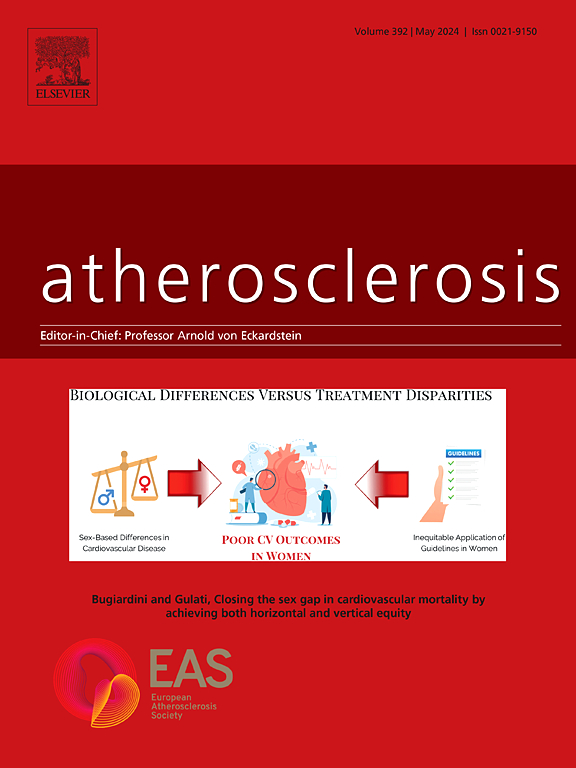KUS121是一种新型的VCP调节剂,通过维持内皮细胞的ATP水平来减少内质网应激和抑制糖酵解,从而减缓动脉粥样硬化的发展
IF 5.7
2区 医学
Q1 CARDIAC & CARDIOVASCULAR SYSTEMS
引用次数: 0
摘要
背景和目的内质网(ER)应激通路参与动脉粥样硬化的进展。最近,我们开发了京都大学物质(KUS) 121,它可以选择性地抑制含缬草苷蛋白(VCP)的ATP酶活性,从而保护细胞内ATP消耗并减轻内质网应激。本研究评估了KUS121在动脉粥样硬化中的疗效。方法和结果每天给Apoe−/−小鼠注射skus121,连续8周。KUS121治疗导致动脉粥样硬化进展减少40 - 50%。有趣的是,我们观察到C/EBP同源蛋白(Chop),一种公认的内质网应激标志物,主要在斑块内皮中表达。在人EA.hy926内皮细胞中,KUS121可阻止内质网应激诱导的凋亡,并下调肌醇要求酶1α (IRE1α)相关炎症通路。与这些体外研究结果一致,通过TUNEL和cleaved caspase-3染色显示,KUS121处理显著减少了内皮细胞凋亡,通过免疫染色显示,KUS121处理显著减少了斑块内皮细胞核因子κB (NF-κB)和细胞间粘附分子(Icam) 1的炎症。我们还通过单波长和基于fret的荧光ATP传感器证明了KUS121维持EA.hy926细胞和动脉粥样硬化斑块病变中的ATP水平。丙酮酸甲酯补充细胞内ATP可减弱内质网应激诱导的内皮细胞凋亡和炎症通路,类似于KUS121。除了影响内质网应激外,在lps处理的EA.hy926细胞中,KUS121还通过增加细胞内ATP水平抑制糖酵解,从而在没有内质网应激的情况下减轻炎症。结论skus121可通过维持细胞内ATP水平,降低内质网应激和斑块内皮糖酵解,成为治疗动脉粥样硬化性疾病的新选择。本文章由计算机程序翻译,如有差异,请以英文原文为准。

KUS121, a novel VCP modulator, attenuates atherosclerosis development by reducing ER stress and inhibiting glycolysis through the maintenance of ATP levels in endothelial cells
Background and aims
Endoplasmic reticulum (ER) stress pathways contribute to atherosclerosis progression. Recently, we developed Kyoto University Substance (KUS) 121, which selectively inhibits ATPase activities of valosin-containing protein (VCP), consequently conserving intracellular ATP consumption and mitigating ER stress. This study evaluated the efficacy of KUS121 in atherosclerosis.
Methods and results
KUS121 was administered daily to Apoe−/− mice fed a Western diet (WD) for 8 weeks. KUS121 treatment resulted in a 40–50 % reduction in atherosclerosis progression. Interestingly, we observed that C/EBP homologous protein (Chop), a well-established ER stress marker, was predominantly expressed in plaque endothelium. In human EA.hy926 endothelial cells, KUS121 prevented ER stress-induced apoptosis and downregulated the Inositol-requiring enzyme 1 alpha (IRE1α)-associated inflammatory pathways. Consistent with these in vitro findings, KUS121 treatment significantly reduced endothelial apoptosis, as shown by TUNEL and cleaved caspase-3 staining, and inflammation, as demonstrated by immunostaining of Nuclear factor kappa B (NF-κB) and Intercellular adhesion molecule (Icam) 1 at plaque endothelium. We also demonstrated that KUS121 maintained ATP levels in EA.hy926 cells and atherosclerotic plaque lesions using single-wavelength and the FRET-based fluorescent ATP sensors. Supplementation of intracellular ATP by methyl pyruvate attenuated ER stress-induced apoptotic and inflammatory pathways in endothelial cells, similar to KUS121. Besides affecting ER stress, KUS121 also reduced inflammation even without ER stress by inhibiting glycolysis through increased intracellular ATP levels in LPS-treated EA.hy926 cells.
Conclusions
KUS121 can be a new therapeutic option for atherosclerotic diseases by maintaining intracellular ATP levels, leading to the attenuation of ER stress and glycolysis in plaque endothelium.
求助全文
通过发布文献求助,成功后即可免费获取论文全文。
去求助
来源期刊

Atherosclerosis
医学-外周血管病
CiteScore
9.80
自引率
3.80%
发文量
1269
审稿时长
36 days
期刊介绍:
Atherosclerosis has an open access mirror journal Atherosclerosis: X, sharing the same aims and scope, editorial team, submission system and rigorous peer review.
Atherosclerosis brings together, from all sources, papers concerned with investigation on atherosclerosis, its risk factors and clinical manifestations. Atherosclerosis covers basic and translational, clinical and population research approaches to arterial and vascular biology and disease, as well as their risk factors including: disturbances of lipid and lipoprotein metabolism, diabetes and hypertension, thrombosis, and inflammation. The Editors are interested in original or review papers dealing with the pathogenesis, environmental, genetic and epigenetic basis, diagnosis or treatment of atherosclerosis and related diseases as well as their risk factors.
 求助内容:
求助内容: 应助结果提醒方式:
应助结果提醒方式:


